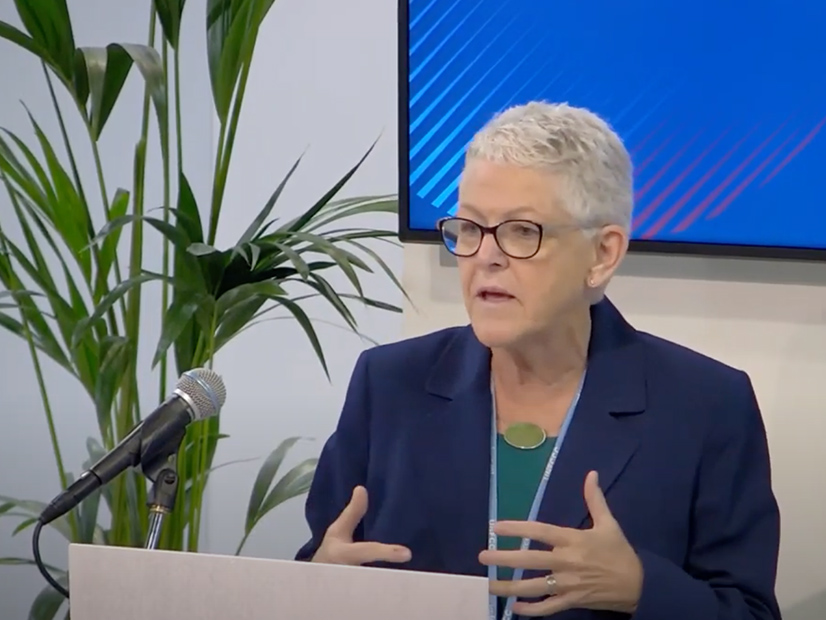The U.N. Climate Change Conference (COP26) in Glasgow, Scotland, continues this week with an impetus that U.S. National Climate Advisor Gina McCarthy, executives from several U.S. utilities and the Edison Electric Institute agreed was not always clear at previous global climate conferences: a cohesive U.S. mission.
“We were so impressed not only at EEI, but … all of our companies were impressed by how quickly this administration started leading from Day 1,” Pedro Pizarro, CEO of Edison International (NYSE:EIX) and vice chairman of EEI, said during a discussion session Friday sponsored by EEI and held at the State Department’s U.S. Center at COP26.
“In some ways we are a small player relative to the global community that is here, but all of us have our part to play in this,” Pizarro said.
He compared the challenge of dealing with climate change to the successful effort by medical scientists and policymakers around the world to develop a COVID-19 vaccine and make it available. “COVID was an existential crisis. This is another existential crisis.”
McCarthy explained the administration’s objective this way: “I want the world to know that the United States is back. I want the world to know that clean energy is not just the rest of the world’s future, but it is our future, and we intend to lead that future together.
“This is not about technologies. And it’s not about just one country. It’s about our world. It’s about recognizing that climate change demands actions that have to be taken right away and at scale, if we hope to deliver our children a future that we can be proud of,” she said.
Emphasizing that the administration’s goal is to foster domestic public-private partnerships, McCarthy also stressed that “President Biden knows that this isn’t just about clean energy. It’s about two-plus years of people stuck in their homes, wondering what the future is going to look like.
“And that future has to be hopeful,” she said emphatically. “That future has to be filled with new jobs, new growth opportunities. That’s what this is really all about.”
John Pettigrew, CEO of National Grid (NYSE:NGG), seemed to agree with McCarthy’s assessment of Week 1 of the conference and the administration’s goals for the U.S. energy markets.
“I’m finishing the first week with a sense of optimism because of the progress that’s been made,” he said. “Some of the announcements that we’ve seen and the commitments that have been made over the last week — whether it’s methane, whether it’s the phasing out of coal — some of the individual country commitments are much bigger than perhaps we could have anticipated. … We’ve got a real momentum that’s going to build as we come off COP26. The reality is that over the last 10 years, it feels like we’ve been jogging towards a goal line. We now need to start to sprint.
Ralph Izzo, CEO of Public Service Enterprise Group , headquartered in Newark, N.J., said the Biden administration’s efforts to facilitate offshore wind has created “a tremendous amount of investment in the region so that prices of projects “are actually coming down.”
“We’re investing over a billion dollars in offshore wind,” Izzo said. “We have approval to invest $150 million in the next year [for] electric vehicle charging stations. We’re asking for another $250 million to do more of that in New Jersey. All of that pales in comparison to the 13 million tons of carbon per year that we avoid by producing 30 TWh of nuclear power.”
On the West Coast, the challenge facing Edison International subsidiary Southern California Edison is a good example of what it will take to achieve the Biden administration’s goals, Pizarro said. California has set an overall target to have net-zero emissions by 2045 by electrifying transportation and heating and cooling in buildings.
“It’s a transition that’s doable, but it relies on clean electricity to repower a lot of the economy. Clean electricity will require the addition of something like 80 GW of renewables to the bulk power [grid] statewide, along with 30 GW of storage.
“Distributed [generation] is important too. We see the need for 30 GW of distributed renewables with 10 GW of distributed storage. That level of deployment will require a significant investment across the California economy. We estimate $250 billion statewide for those resources along with the grid investments needed to connect,” he said.
New Mexico is another sun-drenched state moving in a similar direction, and Pat Vincent-Collawn, CEO of PNM Resources (NYSE:PNM), recalled her company’s decision to shut down two coal plants when McCarthy was head of EPA, during the Obama administration. This year the company will shut down two more coal boilers and replace them with solar and batteries. New Mexico’s target is to be carbon free by 2040, she said.


